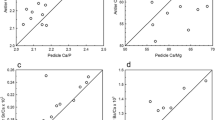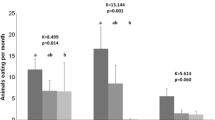Abstract
Previous studies have shown that antler mineral composition reflects diet. Thus, management involving diet can influence both the mineral composition and mechanical properties of antlers. However, it is not known if reducing population density, which increases availability of food, can compensate mineral deficiencies arising from lack of minerals in plants and, ultimately, in the soil. The present study aimed at assessing if private management often involving a balanced food supplementation produced differences in antler properties compared to both public management and reference antlers from deer farms. We also examined if low population density in a National Park could compensate for mineral deficiencies found in antlers of other public reserves or else, antlers still differed in antler characteristics compared to supplemented deer in private game estates. We used 120 antlers from three public reserves, four private game estates and two deer farms as reference to assess antler composition, mechanical properties, size and structure. Public managed antlers had shorter length compared to private and reference ones, thinner cortex (CT), were less dense, had lower second moment of area (I) and work to fracture (W). In addition, they had content in ash, Ca, Mg, Na, S and Zn lower than antlers from private game estates. In contrast, antlers from public reserves had greater values of Young’s modulus of elasticity (E), Fe, Mn and Si. In most cases, antlers from private management and reference farms showed similar values. When comparing antlers from low population density in a National Park with antlers from private management, differences in antler length, CT, I and ash disappeared, but both differed still in density, E, bending strength, W and content in all minerals mentioned. In conclusion, low density can improve some structural variables, but it cannot compensate for mineral deficiencies whereas food supplementation can.


Similar content being viewed by others
References
Augustine DJ, DeCalesta D (2003) Defining deer overabundance and threats to forest communities: from individual plants to landscape structure. Ecoscience 10:472–486
Baxter BJ, Andrews RN, Barrel GK (1999) Bone turnover associated with antler growth in red deer (Cervus elaphus). Anat Rec 256:14–19
Carranza J (1996) Correlates or territoriality in rutting red deer. Ethology 102:793–805
Ceacero F, Landete-Castillejos T, García AJ, Estévez JA, Martínez A, Calatayud A, Gaspar-López E, Gallego L (2009) Free-choice mineral consumption in Iberian red deer (Cervus elaphus hispanicus) response to diet deficiencies. Livest Sci 122:345–348
Ceacero F, Landete-Castillejos T, García AJ, Estévez JA, Gaspar-López E, Gallego L (2010) Effects of ad libitum mineral consumption in Iberian red deer hinds and calves. Anim Prod Sci 50:37–44
Currey JD (2002) Bones: structure and mechanics. Princeton University Press, Princeton
Currey JD, Landete-Castillejos T, Estevez J, Ceacero F, Olguin A, Garcia A, Gallego L (2009) The mechanical properties of deer antler bone when used in fighting. J Exp Biol 212:3985–3993
Estévez JA, Landete-Castillejos T, García AJ, Ceacero F, Gallego L (2008) Maintenance regime and bone structural effects in composition and radioopacity of Iberian red deer antlers (Cervus elaphus hispanicus). Eur J Wildl Res 54:215–223
Estévez JA, Landete-Castillejos T, Martínez A, García AJ, Ceacero F, Gaspar-López E, Calatayud A, Gallego L (2009) Antler mineral composition of Iberian red deer Cervus elaphus hispanicus is related to mineral profile of diet. Acta Theriol 54:235–242
Gaillard JM, Boutin JM, Delorme D, van Laere G, Duncan P, Lebreton JD (1997) Early survival in roe deer: causes and consequences of cohort variation in two contrasted populations. Oecologia 112:502–513
Garel M, Loison A, Gaillard JM, Cugnasse JM, Maillard D (2004) The effects of a severe drought on mouflon lamb survival. Proc R Soc B (Suppl) 271:S471–S473
Gómez JA, Landete-Castillejos T, García AJ, Sánchez PJ, Estévez JA, Gallego L (2006) Importance of growth during lactation on body size and antler development in the Iberian red deer (Cervus elaphus hispanicus). Livest Sci 105:27–34
Gómez JA, Ceacero F, Landete-Castillejos T, Gaspar-López E, García AJ, Gallego L (2012) Factors affecting antler investment in yearlings, subadults and adults of Iberian deer. Anim Prod Sci 52:867–873
Hummel J, Findeisen E, Sudekum KH, Ruf I, Kaiser TM, Bucher M, Clauss M, Codron D (2011) Another one bites the dust: faecal silica levels in large herbivores correlate with high-crowned teeth. Proc R Soc Lond B Biol 278:1742–1747
Huxley J (1931) The relative size of antlers of deer. Proc Zool Soc London 72:819–864
Hyvärinen H, Kay RNB, Hamilton WJ (1977) Variation in the weight, specific gravity and composition on the antlers of red deer (Cervus elaphus L.). Br J Nutr 38:301–311
Kie JG (1987) Performance in wild ungulates: measuring population density and condition of individuals. General Technical Report PSW-106, pp 1–17
Landete-Castillejos T, García AJ, Gómez JA, Laborda J, Gallego L (2002) Effects of nutritional stress during lactation on immunity costs and indices of future reproduction in Iberian red deer (Cervus elaphus hispanicus). Biol Reprod 67:1613–1620
Landete-Castillejos T, García A, Gómez JA, Gallego L (2003) Lactation under food constraints in Iberian red deer Cervus elaphus hispanicus. Wildl Biol 9:131–139
Landete-Castillejos T, Garcia AJ, Gallego L (2007a) Body weight, early growth and antler size influence antler bone mineral composition of Iberian Red Deer (Cervus elaphus hispanicus). Bone 40:230–235
Landete-Castillejos T, Estevez JA, Martínez A, Ceacero F, Garcia AJ, Gallego L (2007b) Does chemical composition of antler bone reflect the physiological effort made to grow it? Bone 40:1095–1102
Landete-Castillejos T, Currey JD, Estevez JA, Gaspar-López E, García AJ, Gallego L (2007c) Influence of physiological effort of growth and chemical composition on antler bone mechanical properties. Bone 41:794–803
Landete-Castillejos JD, Estevez JA, Fierro Y, Calatayud A, Ceacero F, Garcia AJ, Gallego L (2010a) Do drastic weather effects on diet influence changes in chemical composition, mechanical properties and structure in deer antlers? Bone 47:815–825
Landete-Castillejos T, Gallego L, Estévez JA, Garcia AJ, Fierro Y (2010b) Fencing of game estates in Spain considered as management unit. In: Chapman HG, Hecker K (eds) Enclosures: a dead-end? Influence on game biology, Conservation and Hunting, International Council for Game and Wildlife Conservation. CIC, Sopron, pp 68–79
Landete-Castillejos T, Currey JD, Ceacero F, García AJ, Gallego L, Gomez S (2012a) Does nutrition affect bone porosity and mineral tissue distribution in deer antlers? The relationship between histology, mechanical properties and mineral composition. Bone 50:245–254
Landete-Castillejos T, Estévez JA, Ceacero F, García AJ, Gallego L (2012b) A review of physiological effort, nutrition, and ecological conditions on mineral composition, mechanical properties and internal structure of antlers. Front Biosci E4:2328–2339
Liang Y, Sun W, Zhu YG, Christie P (2007) Mechanism of silicon-meditated alleviation of abiotic stresses in higher plants: a review. Environ Pollut 147:422–428
Ma JF (2004) Role of silicon in enhancing the resistance of plants to biotic and abiotic stresses. Soil Sci Plant Nutr 50:11–18
Ma JF, Yamaji N (2006) Silicon uptake and accumulation in higher plants. Trends Plant Sci 11:392–397
Maki K, Nisioka T, Nishida I, Ushijima S, Kimura M (2002) Effect of zinc on rat mandibles during growth. Am J Orthod Dentofac 122:410–413
McDowell LR (2003) Minerals in animal and human nutrition. Elsevier, Amsterdam
McNaughton SJ (1988) Mineral nutrition and spatial concentrations of African ungulates. Nature 334:343–345
McNaughton SJ (1990) Mineral nutrition and seasonal movements of African migratory ungulates. Nature 345:613–615
Meister W (1956) Changes in biological structure of the long bones of white-tailed deer during the growth of antlers. Anat Rec 124:709–721
Milner-Gulland EJ, Coulson TN, Clutton-Brock TH (2000) On harvesting a structured ungulate population. Oikos 88:592–602
Muir PD, Sykes AR, Barrell GK (1987) Calcium metabolism in red deer (Cervus elaphus) offered herbages during antlerogenesis: kinetic and stable balance studies. J Agric Sci 109:357–364
Murray MG (1991) Maximizing energy retention in grazing ruminants. J Anim Ecol 60:1029–1045
Notario R (2002) 50 años de homologación de trofeos de caza mayor en España. Fórmulas oficiales y metodologías de valoración, los mejores ejemplares de cada especie y evolución de las capturas. WAVES, Zamora
Oreagain PJ (1993) Plant structure and the acceptability of different grasses to sheep. J Range Manage 46:232–236
Ozaki M, Kaji K, Matsuda N, Ochiai K, Asada M, Ohba T, Hosoi E, Tado H, Koizumi T, Suwa G, Takatsuki S (2010) The relationship between food habits, molar wear and life expectancy in wild sika deer populations. J Zool 280:202–212
Parker KL, Gillingham MP, Hanley TA, Robbins CT (1996) Foraging efficiency: energy expenditure versus energy gain in free-ranging black-tailed deer. Can J Zool 74:442–450
Puig S, Videla F, Cona MI (1997) Diet and abundance of the guanaco (Lama guanicoe Muller 1776) in four habitats of northern Patagonia, Argentina. J Arid Environ 36:343–357
Rodenhouse NL, Sherry TW, Holmes RT (1997) Site-dependent regulation of population size: a new synthesis. Ecology 78:2025–2042
Rodriguez-Berrocal J (1978) Introduction to the study and evaluation of red deer (Cervus elaphus L.) food resources in the Sierra Morena: I. Analysis of the deer diet. Arch Zootec 27:73–82
Schmidt KT, Stien A, Albon SD, Guinnes FE (2001) Antler length of yearling red deer is determined by population density, weather and early life-history. Oecology 127:191–197
Seagle SW, McNaughton SJ (1992) Spatial variation in forage nutrient concentrations and the distribution of Serengeti grazing ungulates. Landsc Ecol 70:229–241
Toïgo C, Gaillard JM, van Laere G, Hewison AJM, Morellet N (2006) How does environmental variation influence body mass, body size, and body condition? Roe deer as a case study. Ecography 29:301–308
Torres-Porras J, Carranza J, Perez-Gonzalez J (2009) Combined effects of drought and density on body and antler size of male Iberian red deer Cervus elaphus hispanicus: climate change implications. Wildl Biol 15:213–221
Ullrey DE (1983) Nutrition and antler development in white-tailed deer. In: Brown RD (ed) Antler Development in Cervidae. Caesar Kleberg Wildlife Research Institute, Kingsville, pp 49–59
Acknowledgments
This study was supported by FEDER-MINECO projects CGL2011-24811 and AGL2012-38898. The authors wish to thank to Alberto Martínez for the helpful assistance in the chemical analysis and Yolanda Fierro for providing plant, feed, and antler samples.
Author information
Authors and Affiliations
Corresponding author
Additional information
Communicated by H. Kierdorf
Rights and permissions
About this article
Cite this article
Landete-Castillejos, T., Estevez, J.A., Ceacero, F. et al. Effects of public vs. private management on deer antler composition, mechanical and structural variables. Eur J Wildl Res 59, 519–529 (2013). https://doi.org/10.1007/s10344-013-0699-6
Received:
Revised:
Accepted:
Published:
Issue Date:
DOI: https://doi.org/10.1007/s10344-013-0699-6




